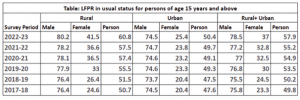Table of Contents
THE CONTEXT: There is a rising concern that the economy is unable to generate sufficient employment to absorb the millions entering the labour force each year with a decline in the unemployment rate and a rise in self-employment.
FINDINGS OF PLFS 2022-23:
- In recent decades, there has been a growing link between economic growth and employment generation
- As per the survey, the labour force participation rate has continued to rise across the country. Alongside, the unemployment rate has continued to decline. However, the survey also documents a decline in the share of regular wage/salaried employment and a rise in self-employment.
LFPR Status in Periodic Labour Force Survey
- At the all-India level, the labour force participation rate (15 years and above) has increased from 49.8 per cent in 2017-18 to 57.9 per cent in 2022-23.
- In rural areas, LFPR increased from 50.7% in 2017-18 to 60.8% in 2022-23 while for urban areas, it increased from 47.6% to 50.4%.
- LFPR for male in India increased from 75.8% in 2017-18 to 78.5% in 2022-23 and corresponding increase in LFPR for female was from 23.3% to 37.0%.
- Female participation rate in rural areas has risen from 24.6 per cent in 2017-18 to 41.5 per cent in 2022-23 — an increase of roughly 17 percentage points over this period.
- While this should be encouraging, considering the low levels of female participation in the country, some have suggested that this rise in participation is indicative of the economic distress in rural areas, which is pushing women to work in order to augment their family incomes.

- The PLFS claimed a decreasing trend in the Unemployment Rate (UR) for persons of age 15 years and above.
- UR in urban areas decreased from 7.6% in April-June 2022 to 6.6% in April-June 2023 for persons of age 15 years and above.
- For male, it decreased from 7.1% to 5.9% during this period and for female, it decreased from 9.5% to 9.1% during this period,”

WHAT IS A PERIODIC LABOUR FORCE SURVEY (PLFS)?
- It was launched in 2017 by the National Sample Survey Office (NSSO) under the Ministry of Statistics and Program Implementation.
- Its objective is to estimate the key employment and unemployment indicators in:
-
- Short time interval of three months for the urban areas only in the ‘Current Weekly Status’ (CWS).
- Both ‘Usual Status’ (ps+ss) and CWS in both rural and urban areas annually.
The key employment and unemployment indicators are defined in periodic labour force survey, as:
- Labour Force Participation Rate (LFPR): LFPR is defined as the percentage of persons in labour force (i.e. working or seeking or available for work) in the population.
It is calculated as:

- Worker Population Ratio (WPR): WPR is defined as the percentage of employed persons in the population.
- Unemployment Rate (UR): UR is defined as the percentage of persons unemployed among the persons in the labour force.
Definitions of CWS and Usual Status
- CWS: The activity status determined on the basis of a reference period of last 7 days preceding the date of survey is known as the current weekly status (CWS) of the person.
- Usual Status: The activity status of a person is determined on the basis of the activities pursued by the person. When the activity status is determined on the basis of the reference period of last 365 days preceding the date of the survey, it is known as the usual activity status of the person.
DIFFERENT TYPES OF UNEMPLOYMENT IN INDIA:
- Disguised Unemployment: It is a phenomenon wherein more people are employed than actually needed. It is primarily traced in the agricultural and the unorganized sectors of India.
- Seasonal Unemployment: It is a type of unemployment that occurs during certain seasons of the year.
- Structural Unemployment: It is a category of unemployment arising from the mismatch between the jobs available in the market and the skills of the available workers in the market.
- Cyclical Unemployment: It is a result of the business cycle, where unemployment rises during recessions and declines with economic growth.
- Frictional Unemployment: It refers to the time lag between the jobs when an individual is searching for a new job or is switching between jobs.
RELATED ISSUES :
- Quality of jobs: Measuring the quality of jobs is a subjective thing, however, by measuring wages, it is being calculated that the quality of jobs in India is very low.
- Informal nature of jobs: Most jobs pay poorly and are of informal arrangements in the unorganised sectors. More than 80% of the workforce in India is engaged in the informal sector, which has suffered the adverse effects of major structural changes in the Indian economy.
- Issue of Jobs in the formal sector: Government data captures only a small portion of the formal sector employment. Also, there is issue of large number of vacancies in the government-run sectors, which are not being filled.
- Jobs in the agricultural sector: Agriculture is absorbing more people than it did in the past. That indicates there’s not much labour transfer happening from farms to factories.
THE WAY FORWARD:
- Increase in Investment: There is a need to have an equal focus on both public and private investment to stimulate demand and generate jobs which should be of a quality nature to increase the productivity of the labour force.
- Skilling and upskilling the workforce: To increase the quality of work, workforce, needs to be skilled and upskilled by providing various trainings and restructuring the entire skill development to adapt to the changing job market.
- Gender inclusive: It is necessary to improve legal equality for keeping the rights of women workforce intact. Major regulations for equal remuneration for work of equal value, allowing women to work at night and in an industrial job in the same way as men, etc need to be implemented.
- Advantage of Demographic dividend: There is a need to reverse the dropout trends of school and college students and engaging them in vocational training to make maximum utilization of the demographic dividend.
THE CONCLUSION: Though there is an increase in the labour force in the country, It is only by raising the quality of skills of its existing workforce, that India will be able to meet its aspirational development goals.
PREVIOUS YEAR QUESTIONS
Q.1 ‘Earn while you learn’ scheme needs to be strengthened to make vocational education and skill training meaningful.” Comment. (2021)
Q.2 “Demographic Dividend in India will remain only theoretical unless our manpower becomes more educated, aware, skilled and creative.” What measures have been taken by the government to enhance the capacity of our population to be more productive and employable? (2016)
MAINS PRACTICE QUESTION
Q.1 There is a need for constant reskilling and upskilling of the workforce to realize the full potential of India’s demographic dividend. Discuss.
Q.2 According to PLFS 2022-33, despite the increase in the labour force and a decrease in unemployment, the quality of work is not up to the mark. What strategies and approaches can be considered as a way forward to address these challenges and maximize the potential of the workforce?
Spread the Word
